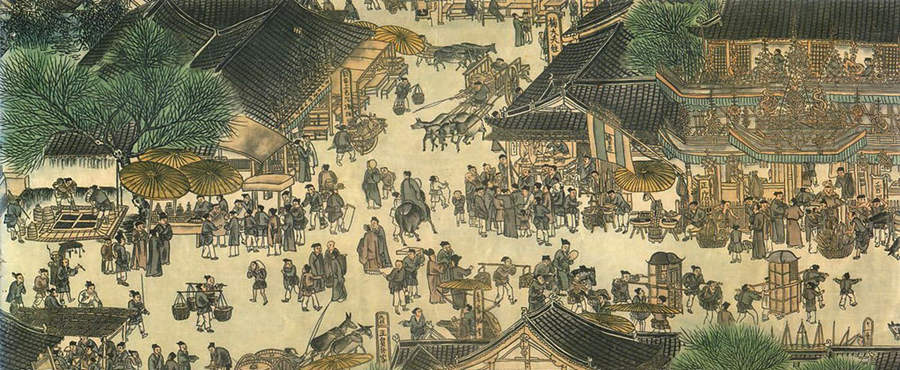Song Dynasty
In 960, the Song Dynasty replaced Tang Dynasty and gained power over most of China and established its capital in Kaifeng, starting a another period of economic prosperity. It was the first government in world history to issue banknotes or paper money, and implemented the first Chinese policy to establish a permanent standing navy.
There are the Northern Song and Southern Song, with a total of 18 emperors that ruled for 319 years. It collapsed twice, both due to external invasion, and was one of the ancinet Chinese dynasties that did not die directly from internal strife.

Song Dynasty Facts
In Chinese: 宋朝
Time period: 960 to 1279
Capital: Dongjing (today’s Kaifeng)
Major cities: Yingtian (Today’s Nanjing), Lin’an (today’s Hangzhou)
Population: 126 million (in 1124), 80.6 million (in 1223)
Currency: coins, paper money
Main ethnical groups: Han
First Emperor: Zhao Kuangying
Area: 2.8 million km² (in the reign period of Zhenghe)
Song Dynasty Timeline & Emperors
| Dynastic Title | Name of the Emperor | Period of Reign | Reign Years | Remarks | |
| Song Taizu | Zhao Kuangying | 960 - 976 | 16 | The first emperor of Song Dynasty | |
| Song Taizong | Zhao Guangyi | 976 - 997 | 21 | ||
| Song zhenzong | Zhao Heng | 997 - 1022 | 25 | Domestic and foreign troubles are becoming increasingly serious | |
| Song Renzong | Zhao Zhen | 1022 -1063 | 41 | ||
| Song Yingzong | Zhao Shu | 1063 - 1067 | 4 | ||
| Song Renzong | Zhao Xu | 1067 - 1085 | 18 | Implement the political reformation of Wang An-shi | |
| Song Zhezong | Zhao Xu | 1085 - 1100 | 15 | ||
| Song Huizong | Zhao Ji | 1100 - 1126 | 26 | A master of calligraphy and painting, and created Shoujinti - a famous calligraphy font | |
| Song Qinzong | Zhao Heng | 1126 -1127 | 1 | The last emperor of Northern Song Dynasty | |
| Song Gaozong | Zhao Gou | 1127 - 1162 | 35 | The first emperor of Southern Song Dynasty | |
| Song Xiaozong | Zhao shen | 1162 - 1189 | 27 | ||
| Song Guangzong | Zhao Dun | 1189 - 1194 | 5 | ||
| Song Ninzong | Zhao Kuo | 1194 - 1224 | 30 | ||
| Song Lizong | Zhao Yun | 1224 - 1264 | 40 | ||
| Song Duzong | Zhao Qi | 1264 - 1274 | 10 | ||
| Zhao Xian | 1274 - 1276 | 2 | |||
| Song Duanzong | Zhao Shi | 1276 - 1278 | 2 | ||
| Zhao Bing | 1278 - 1279 | 1 | The last emperor of Song Dynasty, died at the age of 8 |
What did the Song Dynasty accomplish? -- Achievements
Economy
The Song Dynasty was an era of high prosperity in commodity economy, culture, education and scientific innovation in Chinese history. Some estimates that China's GDP in the year of 1000 was US $26.55 billion, accounting for 22.7% of the world's total, and its per capita GDP was US $450, higher than the US $400 of Western Europe at that time.
The economic progress of Song Dynasty can be attributed to the increased agricultural production. Improved agricultural techniques and tools are important for the development. The introduction of paper money and improvement of the transport facilitated the growth of market and the influx of goods form around the country.
Additionally, printing, paper making, silk weaving and porcelain making all made significant progress in Song Dynasty. Outstanding achievements in maritime and shipbuilding industry resulted in overseas trade to more than 50 countries in the South Pacific, the Middle East, Africa, Europe and other regions.
Song Dynasty Currency: Paper Money & Coins
The earliest paper money appeared in Sichuan area in the early northern Song Dynasty, and became another form of currency in ancient China. There were three kinds of paper money in the Northern Song Dynasty: Jiaozi, Qian Yin and small banknotes. The Northern Song issued a large number of paper money, but up to now, the real northern Song paper money has not survived, probably because the paper was so easy to rot.
Coin was still the most important currency in the Song Dynasty. In the early song Dynasty, the economy developed rapidly, and the amount of coins was 20 times higher than that of the Tang Dynasty. In the 300 years of the Song Dynasty, 18 emperors (the last three emperors survived in name only) changed their chronological names 57 times, thus 43 kinds of coins (not including changes in size and calligraphy).
There coins were made of copper, iron, as well as silver and gold. When the Jin conquered the Northern Song Dynasty, they plundered as much as 10 million ingots of gold and 20 million ingots of silver, indicating that gold and silver money were in large quantities and widely used. In the Song Dynasty, salt notes, tea notes also exercised monetary functions to a certain extent.
Technology & Inventions
The Song was a period of progress in technology and inventions. The application of gunpowder developed rapidly, and the other two of China's Four Great Inventions – printing and compass were invented.
When it comes to the science and technology of the Song Dynasty, people often mention Shen Kuo and his Dream Pool Essays. Dr. Needham praised Shen Kuo as "the most outstanding figure in the whole history of Science in China", and his Dream Pool Essays "the coordinate in the history of science in China".
There were other great achievements made in Song Dynasty, such as medicine, which was divided into nine subjects from the previous three, and produced the world's earliest work on forensic medicine entitled "Xi Yuan Lu". Acupuncture also made great progress. There were 476 more kinds of medicines collected in "Classics and History Proof" than in "Tang Materia Medica".
Culture & Literature
The Song is marked by a revival of old Confucian traditions after the Tang age of Buddhism and a renewal of Confucian learning. Song culture was also a culmination of the heritage of two thousand years of culture. It was regarded as the turning point in China's development of an urban culture.
Great achievements were made in poetry, ci and prose. Although Song poetry was not as good as Tang poetry, it was far above Ming and Qing dynasties, and the whole Song Poetry, which is being compiled, contains more than 160,000 Song poems. Ci is the abbreviation of Qu Ci, also known as long and short sentences. According to the records of the Whole Song Ci, the number of ci writers in the Song Dynasty reached 1,330, and the total number of works and fragments reached more than 20,400. Ci is the signature genre of Song Dynasty literature.
Song Dynasty Art
Painting & Calligraphy
Song Dynasty painting can be divided into landscape painting, figure painting, flower and bird painting. Chinese painting, especially landscape painting, was very mature in the Song Dynasty. It not only depicted the landscape, but also emphasized the artistic conception of the painting. Taoism emphasized Yin and Yang, while Neo-Confucianism in the Song Dynasty emphasized the unity of nature and man, and pursued the moral principles hidden between society and nature. The most famous painting created in Song Dynasty include “Khe Mountain Tour Map”, Riverside Scene at Qingming Festival, and more.
Calligraphy in the Song Dynasty broke away from the style of the Tang Dynasty and broke new ground. The calligraphy of the Sui, Tang and Five dynasties focused on the embodiment of "work", while the calligraphy of the Song Dynasty advocated the part of expressing feelings, which should have "learning", namely "bookliness". Su Shi put forward the slogan "my calligraphy comes from my feelings", his brushwork was tight inside and loose outside, unexpected and changeable. Su Shi, Huang Tingjian, Mi Fu and Cai Xiang are the four masters of calligraphy in the Northern Song Dynasty.
Pottery
The Song Dynasty was a very prosperous period in the history of China's ceramic development. At present, the ancient ceramic sites have been discovered in 170 counties, of which there are kiln sites of song Dynasty in 130 counties, accounting for 75% of the total. Ceramic historians generally summarize the porcelains of the Song Dynasty into six porcelains: the Ding kiln system, Yaozhou kiln system, Jun kiln system and Cizhou kiln system In the north, Longquan celadon system in the south and Jingdezhen celadon system.
Song Dynasty pottery, simple and profound, elegant and sophisticated, with a variety of forms, make Chinese porcelain outstanding in the world.
Song Dynasty Clothing
The Song Dynasty clothing, or Song Hanfu is characterized by custom fit. In the Song Dynasty, whether the royal relatives and relatives of dignitaries or ordinary people, it was a fashion to wear a dress with straight collar and front.
Men's wear generally followed the style of the Tang Dynasty. The common people mostly wore long robes with cross-collars or round collars. When they worked, they put their clothes on the belt. Most clothes were black and white. At that time, retired officials and scholars often wore a long gown with large sleeves and black borders at the cuffs, neckline and corners of the gown. On their heads, they wore a square barrel-shaped hat called dongpo towel.
Song Dynasty dress for women’s wear inherited Tang dress system, and was still dominated by rope, jacket, skirt, and deep dress.
Therefore, the song Dynasty's economy, science and technology, culture were a climax of China. That’s also why Song Dynasty so advanced. But it is also a dynasty with the weakest military value in Chinese history.


